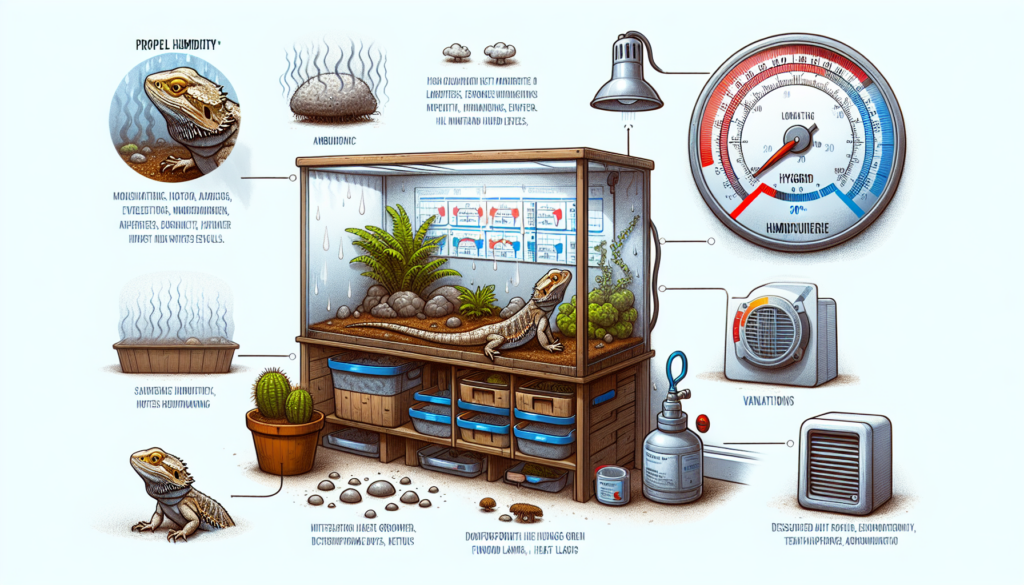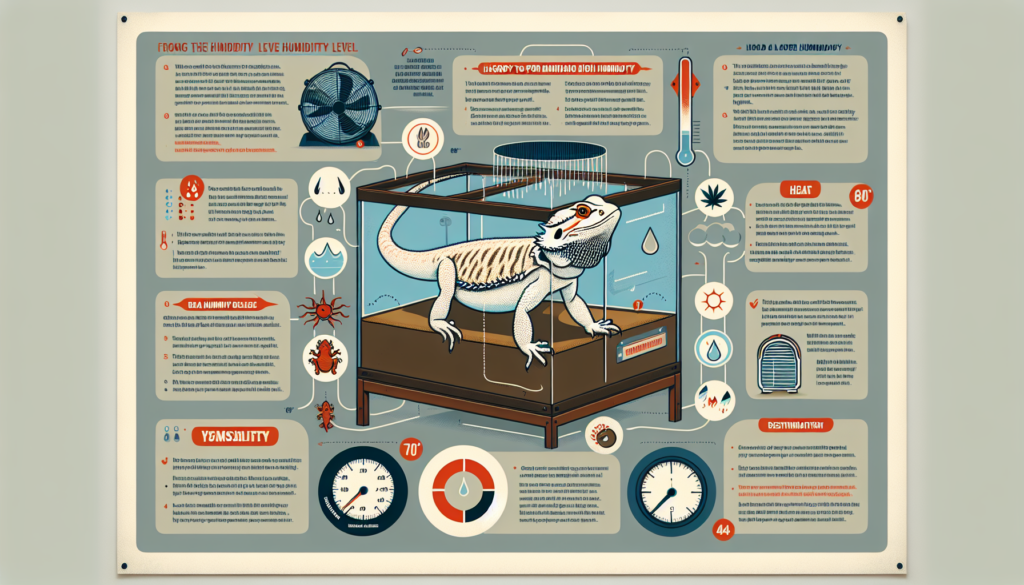If you’re a proud owner of a bearded dragon, you know that maintaining the right environment for them is crucial to their health and happiness. One aspect that can sometimes be a challenge is controlling the humidity levels in their tank. High humidity can lead to respiratory problems and other health issues for these beloved reptiles. In this article, we will explore some practical tips and tricks to help you lower the humidity in your bearded dragon tank, ensuring a comfortable and safe habitat for your scaly friend. Let’s dive in and learn how to create the perfect conditions for your bearded dragon’s well-being.
How To Lower Humidity In Bearded Dragon Tank
Understanding Ideal Humidity Levels for Bearded Dragons
Maintaining the correct humidity levels in your bearded dragon’s tank is crucial for their overall health and wellbeing. Bearded dragons are native to desert regions, so they require relatively low humidity levels to thrive. The ideal humidity range for these reptiles is between 30% and 40%. High humidity levels can lead to respiratory issues and skin infections, so it’s essential to monitor and regulate the moisture in their environment.
Identifying the Causes of High Humidity in the Tank
Before we can effectively lower the humidity in the tank, it’s important to identify the potential causes of high humidity. One common culprit is water sources within the enclosure. If you have a large water dish, excessive misting, or a leaky water source, it can contribute to a rise in humidity. Another factor to consider is the tank’s ventilation. Insufficient airflow can trap moisture and elevate humidity levels. Lastly, the ambient room humidity can also impact the tank’s moisture levels, so monitoring this is important as well.

Ensuring Proper Ventilation in the Tank
To reduce humidity levels in your bearded dragon’s tank, it’s crucial to provide adequate ventilation. Ensure that your tank has vents or mesh on the sides and top to allow for proper airflow. This will help to prevent stagnant air and moisture buildup. Additionally, consider using a fan near the tank to promote circulation. By increasing ventilation, you can prevent the accumulation of moisture in the enclosure and maintain optimal humidity levels.
Managing Water Sources in the Tank
Water sources within the tank can significantly influence humidity levels. If you have a large water dish, consider replacing it with a smaller one. This will minimize the surface area, reducing evaporation and subsequent humidity levels. Additionally, be mindful of how often you mist the tank. Excessive misting can create excess moisture, so limit misting to small amounts when necessary. Finally, check for any leaks in your tank’s water system, as these can contribute to increased humidity.

Controlling Ambient Room Humidity
In addition to managing the tank’s internal humidity, it’s essential to consider the ambient room humidity. The humidity level in your home can impact the moisture in the bearded dragon’s enclosure. Use a hygrometer to monitor the humidity in the room and ensure it stays within an appropriate range. If the room’s humidity is high, consider using a dehumidifier or opening windows to improve air circulation and lower moisture levels.
Using a Dehumidifier
If you’re struggling to control humidity levels in the tank despite these efforts, using a dehumidifier can be an effective solution. A dehumidifier works by removing excess moisture from the air, helping to achieve and maintain the ideal humidity range for your bearded dragon. Place the dehumidifier near the tank but not directly facing it, as this can create temperature extremes. Remember to regularly empty the water collected by the dehumidifier to prevent mold growth.
Using a Humidistat or Hygrometer
To accurately monitor the humidity levels in your bearded dragon’s tank, invest in a humidistat or hygrometer. These devices measure the moisture in the air, giving you real-time readings of the humidity levels. By keeping a close eye on these readings, you can promptly make any necessary adjustments to keep the humidity within the desired range. Place the humidistat or hygrometer where you can easily see it, such as near the tank’s front or on the enclosure’s wall.
Using Heat Lamps or Ceramic Heaters
To help control the humidity in your bearded dragon’s tank, consider using heat lamps or ceramic heaters. These heat sources can help to evaporate excess moisture and maintain optimal humidity levels. By providing a warm and dry environment, you can reduce the risk of respiratory and skin issues for your reptile. However, be cautious not to increase the tank’s temperature excessively, as this can stress your bearded dragon. Always ensure that your heat sources are properly secured and not directly exposed to the enclosure to prevent burns or accidents.
Avoiding Excessive Mistings
While misting can provide much-needed hydration for bearded dragons, excessive misting can contribute to high humidity levels. Be mindful of how often and how much you mist. Reduce misting to a few times a week, focusing on targeting specific areas instead of drenching the entire tank. This will help to maintain a proper balance between hydration and humidity control. Additionally, consider using a sprayer with fine mist settings to minimize the amount of moisture released into the enclosure.
Maintaining a Balanced Temperature and Humidity
To ensure your bearded dragon’s tank provides an optimal environment, it’s critical to maintain a proper balance between temperature and humidity. Bearded dragons thrive at temperatures between 95°F and 105°F (35°C and 40°C) during the day, with a cooler zone of 75°F to 85°F (24°C to 29°C) on the opposite side of the tank. By maintaining these temperature ranges and regulating humidity levels within the recommended range, you can create a comfortable and healthy habitat for your pet.
In conclusion, maintaining the ideal humidity levels in your bearded dragon’s tank is essential for their health and wellbeing. By understanding the causes of high humidity and implementing proper ventilation, managing water sources, controlling ambient room humidity, using dehumidifiers or humidistats, incorporating heat lamps or ceramic heaters, avoiding excessive misting, and balancing temperature and humidity, you can create a suitable and comfortable environment for your lizard companion. Remember to regularly monitor and adjust the humidity levels as needed to ensure your bearded dragon remains healthy and happy.
